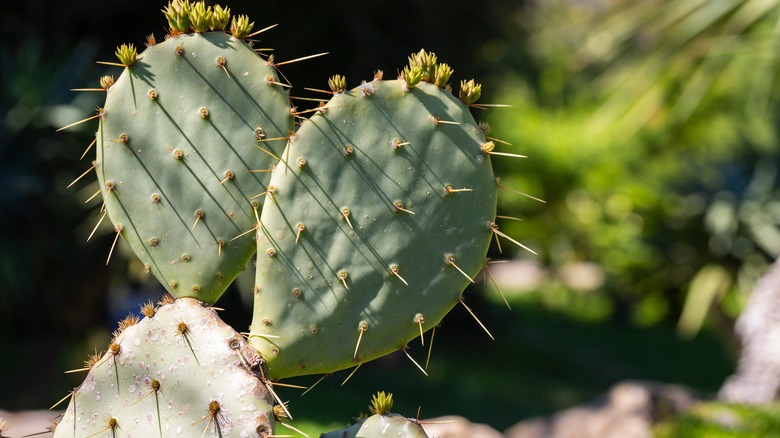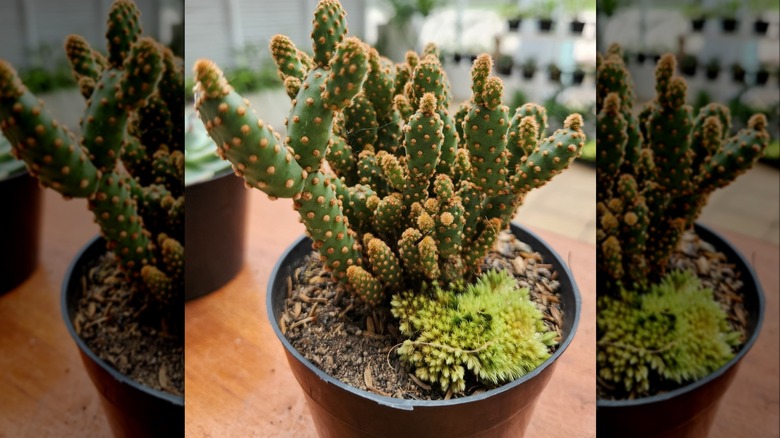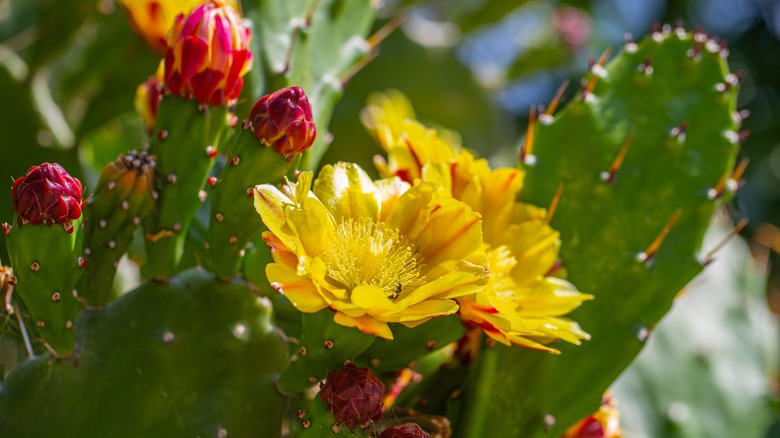Why You Should Grow A Prickly Pear Cactus Next To Your Windows
When NBC New York set out to survey a slew of imprisoned burglars about their modus operandi, they discovered that almost 42% let themselves in through a window left ajar. Worse, nearly 50% couldn't care less about the installed alarm system, raising questions about how protected you should feel behind your four walls. While no single measure can render foolproof security against someone fixated on robbing your home, their task can be made much harder with a second line of razor-sharp defense — sans the barbs or the wire. In short, it's about time you planted some prickly pear cactus (Opuntia spp.).
While some might be familiar with the plant in question thanks to its very edible, highly saccharine prickly pears, that's not the only thing the plant is good for. Like its ilk, a prickly pear cactus produces almost 3-inch long spines on its modified stems (or pads), which some misidentify as leaves. Additionally, a set of tiny, albeit formidable, hairy bristles called "glochids" grow out of the cactus' areoles (bumps). These spines and glochids pack a colossally painful punch if anyone so much as brushes past them, especially if they come into contact with the eyes and skin, and are difficult to remove once embedded. As you can reckon, jumping through a window where those thorns are standing tall and pointy like pre-modern wartime fortified walls is going to be a highly unpleasant, if not downright insurmountable, barrier for many intruders.
Grow prickly pear to secure your home's windows
Although a prickly pear cactus can be grown from seeds, it's best to start with cuttings, as the aim is to quickly establish an additional protective layer around your windows. You can find them at most nurseries or borrow from a gardening friend whose plant's pads are at least six months old. Native plant enthusiasts will especially enjoy growing opuntia plants, as they're likely to find multiple species adapted to their zone. For instance, Beavertail (Opuntia basilaris), Englemann (Opuntia engelmannii), and Mojave (Opuntia erinacea) prickly pear are indigenous to Arizona. Otherwise, you can grow the cactus plants in USDA zones 3 through 11 if the requirements align, as they haven't — so far — showcased aggressive tendencies in the U.S..
As is common to the cactus family, prickly pears flourish in poor, sandy, or shallow rocky soils. In fact, they are your gateway to vaulting on the xeriscaping trend to help your garden better survive a drought. So brilliant is their water-storing habit that, unlike other ornamentals, the prickly pear cactus would much rather go without water while it's establishing itself in the first planting month. They do require over six hours of daily sun exposure, and you don't want to compromise on drainage, as standing water causes root rot. To create an impenetrable barrier by your window, grow prickly pear cactus plants close together, but be sure to account for their final spread at maturity, as varieties can sit anywhere between 3 and 15 feet wide.
Other considerations and precautions for growing prickly pear cactus
If you're concerned about your landscape or window view looking all thorny and desert-like, don't be. The prickly pear cactus is one of the many cacti that bloom with colorful flowers, softening the tough, unfriendly look of its prickly greenish-blue pads. You can find various varieties flowering in the pink to gold spectrum from spring to summer, later making way for edible, burgundy-colored fruit. If cactus wrens visit your area, you might even get to observe their mothering habits, as they love building their football-shaped nests in prickly pear cactus plants. Who knows, their presence might further shock the intruders still nursing their wounds from the plant's spines. Or, even better, confuse the trespassers into thinking someone's home, as the birds' song is eerily similar to the noise of a starting car.
That being said, you need to balance security with safety. In the event of a house fire, you still want your windows to serve as effective escape routes. That's why it's essential to maintain your prickly pear cactus plants just short of the windowsill by pruning them regularly. However, as their glochids are unlikely to differentiate between the grower and burglars, you must protect yourself with safety glasses and thorn-proof gloves while cutting back the plant. Also, keep inquisitive kids and snooping pets away from this cactus, and southeast U.S. denizens may have to watch out for cactus moths, an exotic pest who feasts on this plant.


